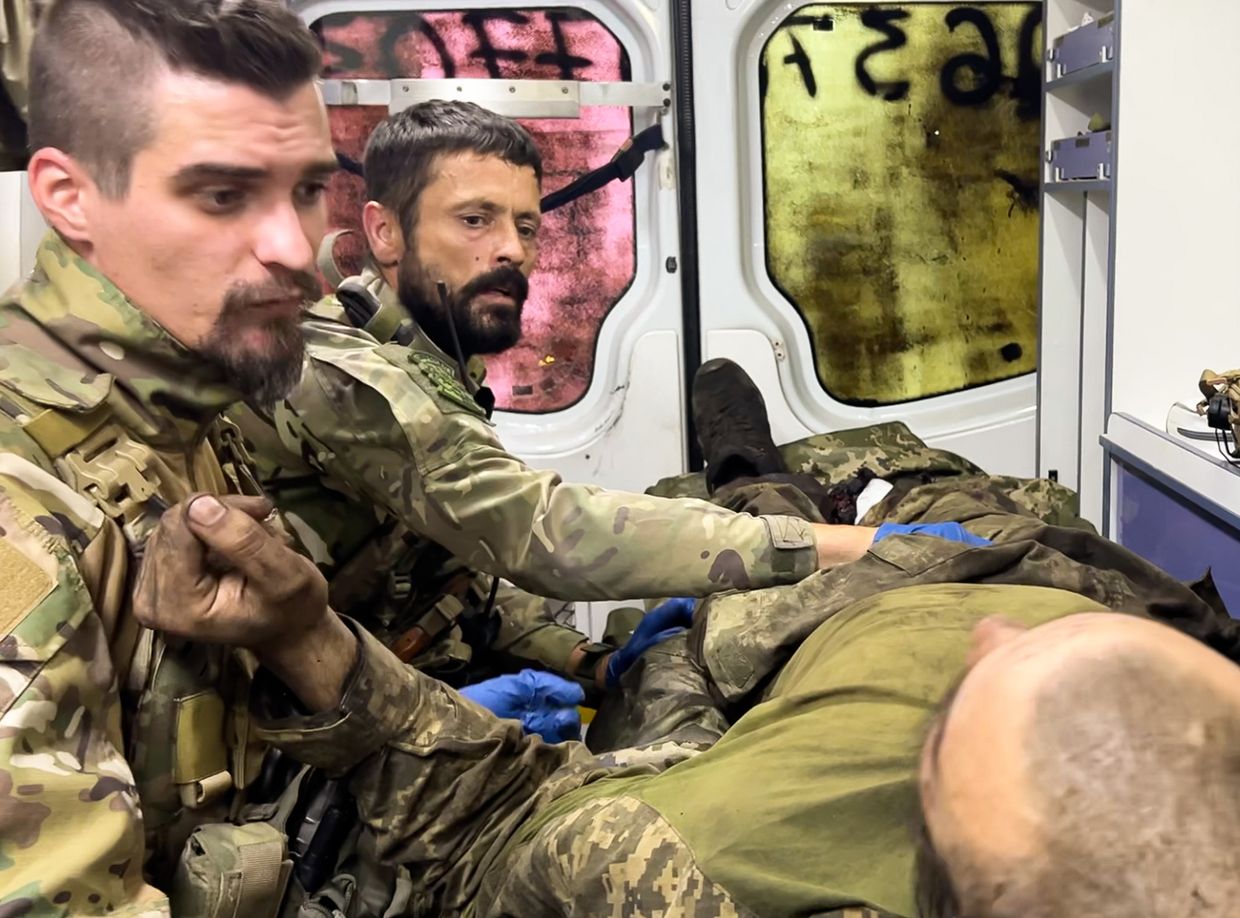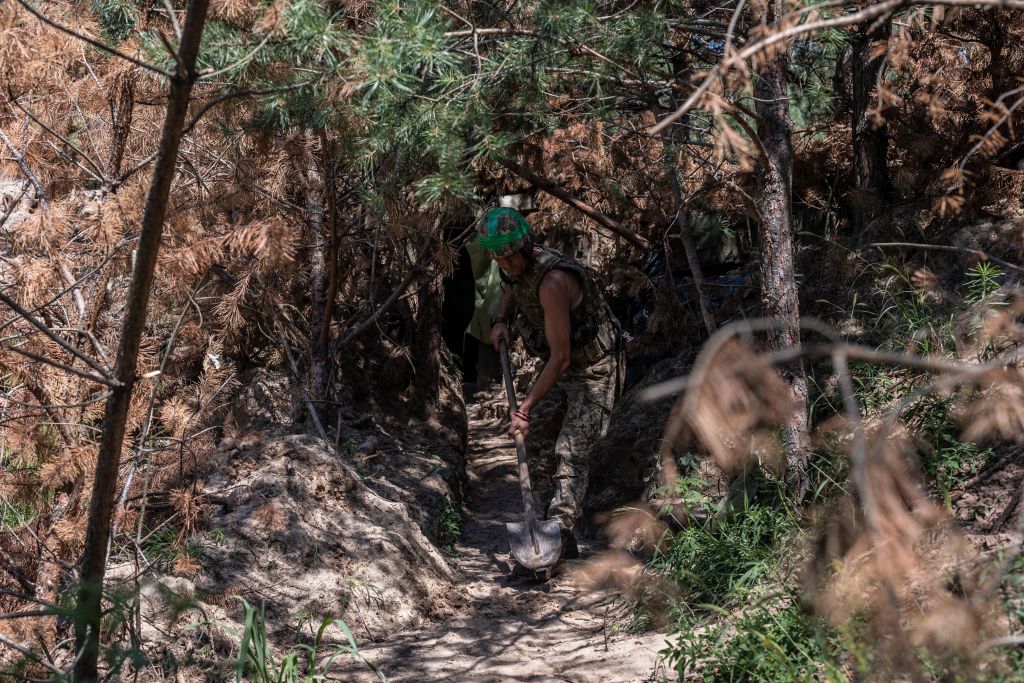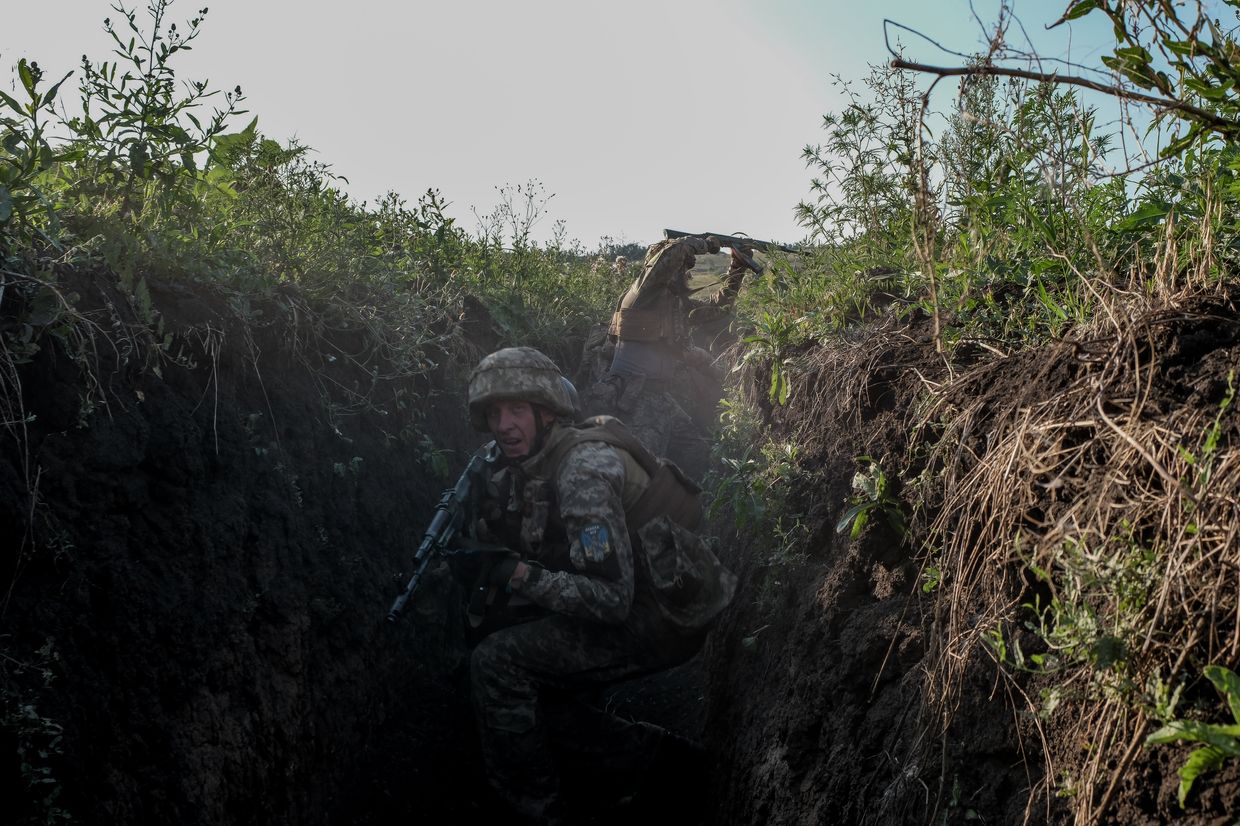As counteroffensive presses forward in southeast, 'every meter costs a life'

Editor's note: The Kyiv Independent is not disclosing the soldiers interviewed in the story by their full names due to security concerns amid the ongoing war in Ukraine. The article also contains photos that some readers may find disturbing.
DONETSK OBLAST – Twenty-nine-year-old assault company commander Bohdan knows what’s at stake when he makes decisions on the battlefield.
“I'm very afraid of making a mistake, because a mistake costs someone's life,” says Bohdan. The Kyiv-native leads a company of up to 100 assault soldiers with the 35th Separate Marine Brigade.
Nearly three months into the counteroffensive, the 35th, along with other units deployed nearby, has crawled southward – approximately 10 kilometers – on the Velyka Novosilka axis in Donetsk Oblast.
Village after village, the Ukrainian soldiers put pressure on the Russian troops – through small regular assaults and striking targets inside the settlements. Once the Russians are sufficiently worn down, Ukrainian forces move forward in strength and retake the villages.
The liberation of the village of Urozhaine – just two kilometers east of the previously liberated Staromaiorske – in mid-August marked Ukraine’s latest notable success on this part of the front.
But any major push forward in this area, like along the rest of the front line, is thwarted by minefields and Russia’s incessant artillery.

Making a breakthrough is extremely difficult, as Russian forces have fortified the area well by digging trenches – 1.5 to 2 meters deep – and heavily mining the fields, roads, and villages.
Ukrainian soldiers anticipate the counteroffensive to continue progress slowly, as a faster advance would mean more losses.
The commanders of platoons and companies, more than anything, fear the price in blood they have to pay for the liberation of more territory – and so speed is the least of their worries.
The battles are challenging and the expectations of the pace it proceeds should be realistic because “this is not a movie,” top Ukrainian officials have said.
Behind the liberation of each village and Western pessimism about the counteroffensive, are the daily efforts of Ukrainian soldiers who are trying to break the Russian defense – at great cost.
And Ukrainian soldiers on the ground say they would rather progress slowly than suffer a higher casualty rate through an over-hasty advance.
Company commander Bohdan says casualties in his unit have been minimal thanks to these careful tactics, and he is determined to keep it this way.
“Anything can happen in a war, but if there are losses, I only blame myself,” Bohdan said.
While he has been a commander since the start of the full-scale war, it’s still as painful as ever to lose a soldier on the battlefield – let alone witness it with his own eyes.
Just recently, one of his squad commanders, 27-year-old Viacheslav, and a fellow soldier were fatally shot during a Russian counterattack while they were clearing the last houses in Staromaiorske – just a day before the village was liberated.
A Ukrainian recon drone was filming the scene, and Bohdan watched it all from a command post about a kilometer away, on the screen of the drone’s control unit.
“When you see everything, but you can't do anything – that’s the most terrible, and the most difficult thing. Seeing how you lose people,” Bohdan said. “I wasn’t next to him (Viacheslav) at the time, and that’s why I blame myself.”
“Every meter costs someone’s life,” Bohdan told the Kyiv Independent, shortly after attending Viacheslav’s funeral in Kyiv.
Tug of war
The assault teams – such as Bohdan’s company with the 35th Marines – go in first to liberate a village, followed by medics to evacuate the wounded as soon as possible.
Evacuations, however, are extremely difficult during assault operations, as the wounded need to be carried to waiting infantry vehicles a few kilometers away. Russian forces also target the medical evacuation vehicles, according to Ukrainian soldiers.
When liberating a village, the soldiers – usually in small teams of up to 10 – have to go house by house, street by street, clearing them of Russian troops: First by throwing grenades, then entering buildings to shoot any remaining Russian soldiers.
According to the Ukrainian soldiers, more than half of the Russian troops deployed in houses in villages flee to other positions after heavy Ukrainian artillery and mortar attacks, likely fearing that their defense won’t hold.
“That’s why if the artillery works beautifully, the infantry can go there more or less safely and start moving according to their assigned route,” Bohdan said.
But not all of the Russians flee. Those who stay behind are ready to defend their position with everything, which leads to close-range skirmishes – as close as five meters – among the houses in a village.
And retaking a Russian position is far from the end of an operation.
As soon as the assault troops capture a Russian position, the main infantry goes in to stabilize it – such as by digging new trenches if it is in a field, and clearing any mines that don’t require the attention of sappers.
Holding on to the newly regained position is extremely difficult, according to the Ukrainian infantrymen. Likely possessing exact coordinates of their former positions, Russian forces fire at them with “all they have” very accurately and try to destroy everything, soldiers with the 35th and 38th Separate Marine Brigade said.
Then come Russian infantry assaults to try to take back the positions. The Russian troops, in some cases, do manage to take back the positions. It is almost like a tug of war, with the front line moving back and forth with the battle, Ukrainian soldiers say.
That was the case with Urozhaine, when the Ukrainian General Staff reported Russia repeatedly attempting to retake the village.
Despite the danger of such operations, a 20-year-old assault group leader with the 35th brigade, also named Bohdan, said he is exactly where he wants to be because “to destroy the most (Russians) you need to get right up close to them.”
Bohdan, who goes by the callsign Bandera, was studying in a military academy in Lviv when the full-scale invasion began, already knows the brutality of the war too well – he himself was almost killed when shrapnel struck close to his heart last year.
Bohdan says he has a rule for himself to never make friends in the army because it would be too difficult if something happens to them – and emotion is distracting in war.
And as a commander, Bohdan knows that he needs to do everything to maximize his soldiers’ chances of survival – not letting human factors get in the way.
“It’s really hard to lose a close person, and since I am a commander, I can’t allow myself to be emotional,” Bohdan said.
A distraction for Russian forces
Many of the soldiers deployed in the area believe that a significant breakthrough in Donetsk Oblast, where Russia has concentrated the most number of troops, is unrealistic, especially at this stage in the war.
Multiple soldiers with the 38th and the 59th Separate Motorized Brigade, both deployed in the region, told to the Kyiv Independent that Ukraine’s operations in Donetsk Oblast – on the Bakhmut and Velyka Novosilka axes – are possibly distractions from the most important operation, the one in Zaporizhzhia Oblast.
Ukraine has retaken a handful of villages on the banks of the Mokriy Yaly River on the Velyka Novosilka axis, as well as settlements near Bakhmut. But in Zaporizhzhia Oblast, they appear to be building up for a potential breakthrough.
Meanwhile, the villages that have been liberated in southern Donetsk Oblast hold no strategic importance, but help boost the morale of all Ukrainian soldiers, said Petro, a 47-year-old platoon commander with the 38th brigade.
Petro, who has served in the army since 2014, is serving with one of the newly formed brigades that went through five months of training before participating in the counteroffensive.
From July, his unit launched small assaults to probe Russian defenses in Urozhaine, mixing them with several large-scale attacks – which included tanks, infantry vehicles, and artillery support.
But new brigades – composed of both newly mobilized soldiers and some officers transferred from more experienced units – struggle due to lack of battlefield experience, and have problems with coordination within the unit, many soldiers told the Kyiv Independent.
Petro said that the five months of training was enough to prepare his mobilized soldiers for a variety of tasks, yet some things are possible to pick up only after actual battles.
“No one can teach you it (in training),” Petro said.
______________________________________________________
Note from the author:
Hi, this is Asami Terajima, the author of this article.
Thank you for reading our story. I was very moved, but also heartbroken, to hear the stories of how Ukrainian commanders – some of whom are younger than me – are risking everything to make sure Ukraine proceeds in the high-stakes counteroffensive. The commanders I interviewed for this story were only worried about the well-being of their soldiers – and not about themselves.
To help the Kyiv Independent continue telling stories that may otherwise be untold, please consider becoming our supporter.









































